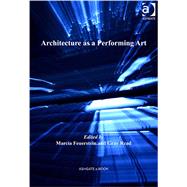Architecture As a Performing Art
, by Feuerstein,Marcia- ISBN: 9781409442356 | 1409442357
- Cover: Hardcover
- Copyright: 4/15/2013
From the time of the Greek polis, through the Italian baroque city to the present day, architecture has played an explicit role in the performance of urban life. This volume frames a tradition of architectural thought allied with the performing arts, which is rooted in ancient practice and has been reinvented continuously as architecture has transformed over centuries. Rather than examining how buildings look as objects apart from people, this book concerns itself with how architecture acts between, among and surrounding people, particularly in the city. It casts buildings as partners in motion, as the stair meets the foot and the railing the hand, windows frame views either inward to present other people or outward to a landscape, releasing theeye. In addition, architecture is the setting or world that defines all action in place, giving it scale, orientation, and meaning, so that a greeting in a supermarket is vastly different than the same greeting in a bedroom, even if the words are identical. An architect's habits of mind that develop in and through performance foster a creative imagination that leads architects to intuitively ask: how might people play out stories in this place, and how might I imagine a place that can play withstrength and character in many stories?This interdisciplinary collection brings together essays that reach back to the earliest civilisations, through the Renaissance, then focusing on the poignant moment in the 1920s and 30s when modern architecture veered most closely to the arts of performance, for example, by including theatre workshops in the Bauhaus curriculum. Other essays then present recent theatricalexperimentation by architects in academic design studios or as part of design practice.In doing so, they fill a significant gap in architectural history and criticism by recognizing a continuous seam of architectural imagination that underlies many of the qualities of urban experience that we intuitively love and remember, yet cannot quite describe. We note events and people and perhaps a view or a detail, yet have limited language to understand the role that architecture played in making them memorable.The book argues that this consideration of design in action is particularly crucial now, as the challenges of sustainability and the demand for liveable cities invite architectural invention to focus on rethinking and remaking urban life. For architects, the playful exploration of the intense relationship between people and place, or people in place is central to designing buildings thatplay well in the multiple, intersecting narratives of the city. The quality of urban life builds in the sparks of creative inhabitation, each one a performance of sorts that springs out of a story, a place, and often someone watching. The role of architectural design in bringing these elements together is crucial. Suspended between everyday life and self-conscious performance, architecture at its best can make the profane profound and invite us to experience the beauty of quotidian life.







